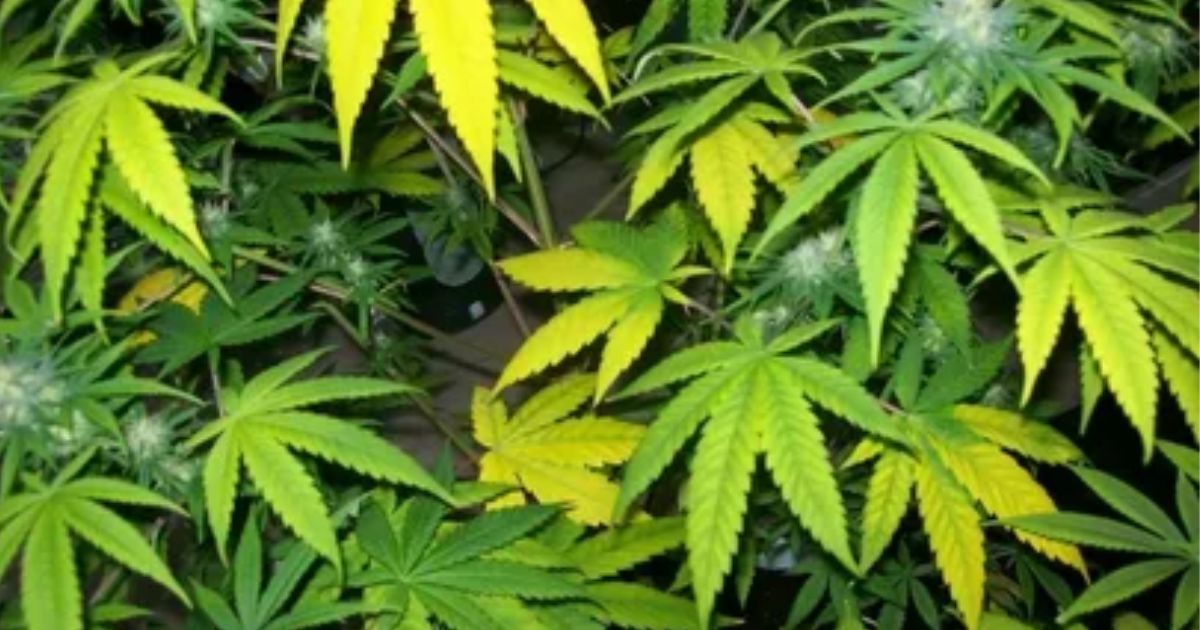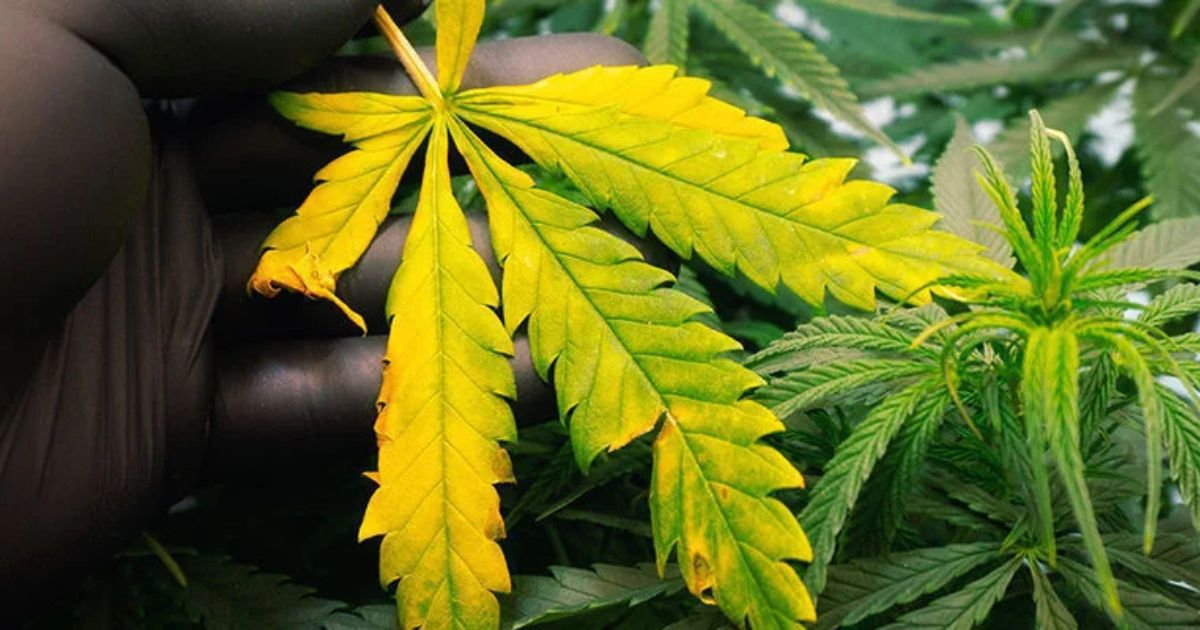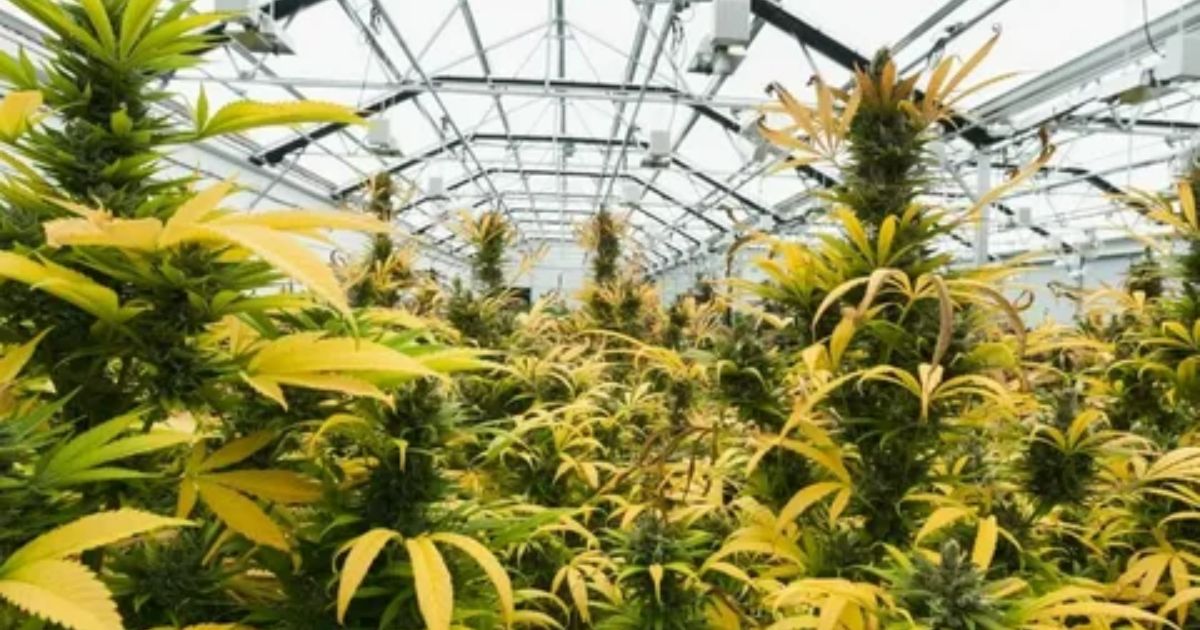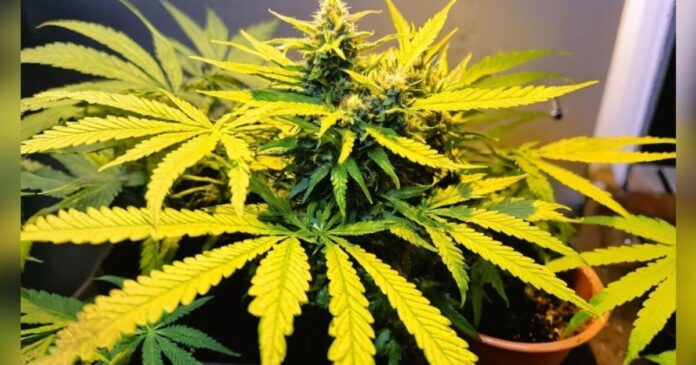Seeing your weed plant’s leaves turn yellow can be worrying, especially when you’re not sure what’s causing it. Yellowing leaves are one of the most common signs that something in your plant’s environment isn’t quite right. It could be a sign of nutrient deficiency, watering problems, pH imbalance, or even pests.
Understanding the reason behind this discolouration is the first step toward saving your crop. In most cases, yellow leaves don’t mean your plant is dying; they’re simply a cry for help. By learning how to identify the cause early, you can take quick action to restore your plant’s health and ensure a strong, green, why are my weed plants leaves turning yellow and productive cannabis garden.
Understanding Yellow Leaves on Weed Plants
When your weed plant’s leaves start turning yellow, it’s a clear sign that the plant is under stress or facing an imbalance. Yellowing can occur at different growth stages, from seedlings to flowering, and the location of the yellow leaves often hints at the underlying problem.For example, if lower leaves turn yellow first, it usually points to a nutrient deficiency such as nitrogen loss. On the other hand, yellowing on new growth often signals issues like pH imbalance or nutrient lockout. Sometimes, the cause is simply overwatering or poor drainage, which prevents roots from breathing correctly.
It’s also important to remember that not all yellowing is bad. As cannabis plants mature, some older leaves naturally turn yellow and fall off, Cannabis Leaf Pics : Types Benefits and Uses especially during the late flowering stage. The key is to observe the pattern, speed, and location of yellowing to determine whether it’s part of the plant’s life cycle or a sign of stress that needs your attention.
Common Causes of Yellow Leaves on Weed Plants
Yellow leaves can appear for several reasons, and each cause affects the plant differently. Identifying the specific issue early helps you correct it before it spreads and impacts growth or yield. Below are the most common reasons your weed plant’s leaves may be turning yellow:

Nutrient Deficiencies
Lack of vital nutrients is one of the main reasons why leaves become yellow. Nutrients. Cannabis plants require a balanced supply of nitrogen (N), phosphorus (P), potassium (K), and micronutrients.
- Nitrogen Deficiency: Usually affects older, lower leaves first. They turn pale yellow and eventually fall off.
- Magnesium Deficiency: Causes yellowing between leaf veins, leaving green lines.
- Iron Deficiency: Affects newer leaves,yellow leaves on cannabis plant turning them pale yellow with darker veins.
Use a balanced nutrient mix suitable for your plant’s growth stage and check pH levels to ensure proper nutrient absorption.
Overwatering or Underwatering
Both too much and too little water can cause yellow leaves. Overwatered roots can’t access oxygen, leading to slow growth and drooping yellow leaves. Underwatered plants, meanwhile, dark vein yellow outside weed show dryness and crisp yellow edges.Only water when the soil’s top inch seems dry. Ensure pots have good drainage and avoid letting roots sit in soggy soil.
pH Imbalance
Cannabis plants thrive in specific pH ranges: around 6.0–7.0 for soil and 5.5–6.5 for hydroponics. When pH drifts outside this range, nutrient lockout occurs, meaning nutrients are present but unavailable to the roots. Cannabis Flowering Stages – Guide To Weed Budding Week By Week Test your water and soil regularly using a pH meter and adjust using pH up/down solutions.
Light Stress
Improper lighting is another frequent cause. Too much light can bleach and burn weed leaf yellowing while too little light prevents photosynthesis, leading to yellowing and weak growth.Keep grow lights at the recommended distance from the canopy and ensure even light coverage.
Temperature and Humidity Issues
Cannabis prefers consistent temperatures between 68–77°F (20–25°C). Excessive heat causes dehydration and yellow leaves, while cold temperatures slow metabolism. Similarly, improper humidity affects nutrient uptake and transpiration.Maintain stable grow room conditions with proper ventilation and a hygrometer to monitor humidity.
Pests and Diseases
Among the insects are spider mites, thrips, and aphids. They consume leaf sap, resulting in yellow patches or dots. Additionally, fungi that cause diseases like powdery mildew and root rot can lead to yellowing as they weaken the plant. Inspect leaves (especially undersides) regularly. Use organic insecticides or neem oil and ensure airflow to prevent mould or fungus.
How to Diagnose the Exact Cause
When your weed plant’s leaves start turning yellow, it’s crucial to figure out the exact cause before taking corrective action. Yellowing can result from multiple issues at once, so careful observation and a step-by-step approach are key.
Observe the Pattern of Yellowing
- Lower leaves turning yellow first: Often a nitrogen deficiency or natural ageing.
- New growth yellowing: Could indicate pH imbalance, iron deficiency, or nutrient lockout.
- Spotty or patchy yellowing: May signal pests or disease.
Pay attention to whether yellowing spreads quickly or slowly, and note any other symptoms like curling, wilting, or spots.
Check Watering Habits
- Put a finger into the ground about an inch deep:
- Soggy soil: Overwatering is likely.
- Dry soil: Underwatering could be the problem.
- Ensure pots have proper drainage to prevent root oxygen deprivation.
Test Soil or Water pH

- Use a pH meter or test kit to measure the pH of soil or hydroponic solution.
- Ideal ranges:
- Soil: 6.0–7.0
- Hydroponics: 5.5–6.5
- pH outside these ranges can cause nutrient lockout, How to Grow Your Own Black jack Strain even if nutrients are present.
Inspect for Pests and Diseases
- Check the undersides of leaves for mites, aphids, or eggs.
- Look for spots, powdery residue, or mould on leaves and stems.
- Healthy roots should be white and firm; brown or slimy roots indicate rot.
Evaluate Nutrient Levels
- Review your feeding schedule and nutrient mix.
- Consider adding specific supplements if a deficiency is suspected.
- Avoid overfertilizing, hempushpa syrup uses in marathi as excess nutrients can burn roots and leaves.
Assess Environmental Conditions
- Check light intensity and distance from plants.
- Monitor temperature and humidity, ensuring they are within optimal ranges.
- Sudden environmental changes can stress the plant, leading to yellowing.
By carefully examining these factors, you can pinpoint whether yellow leaves are due to nutrition, watering, pests, disease, or environmental stress, and take the proper corrective steps before the problem worsens.
Preventing Yellow Leaves in the Future
Once you’ve identified and corrected the causes of yellowing leaves, the next step is to prevent it. weed tree leaves turning yellow Maintaining consistent care and monitoring your weed plants can significantly reduce the risk of future yellow leaves. Here’s how to keep your plants healthy and green:
Maintain a Balanced Nutrient Schedule
- Give your plants the right amount of food for their stage of growth. Seedling, vegetative, and flowering.
- Use high-quality fertilizers or organic nutrients to ensure all essential macro and micronutrients are available.
- Steer clear of overfeeding, Common Mistakes That Stop Buds from Flowering which can cause nutritional burn and more yellowing.
Monitor Watering Practices
- Only water when the soil’s top inch seems dry.
- Ensure pots have proper drainage to prevent root rot from overwatering.
- Adjust watering frequency based on temperature, humidity, and plant size.
Keep pH Levels in Check.
- Regularly test the soil or hydroponic solution pH.
- Maintain optimal pH ranges to ensure nutrient absorption:
- Soil: 6.0–7.0
- Hydroponics: 5.5–6.5
- Adjust pH gradually to prevent shocking the plant.
Maintain Optimal Light, Temperature, and Humidity
- Keep lights at the recommended distance from the canopy to avoid burn or stretch.
- Maintain stable temperatures (68–77°F or 20–25°C) and humidity levels appropriate for each growth stage.
- Use fans, vents, and humidifiers/dehumidifiers to stabilize the grow environment.
Regularly Inspect for Pests and Diseases
- Check leaves, stems, and roots frequently for signs of infestation or infection.
- Treat early with organic insecticides, magiccann canna gummies neem oil, or fungicides as needed.
- Good airflow and cleanliness reduce the risk of mould, mildew, and pest problems.
Remove Dead or Severely Yellow Leaves
- Trim old or damaged leaves to redirect energy to healthy growth.
- Helps improve light penetration and airflow within the canopy.
Keep Detailed Records

- Track watering, feeding, pH, light cycles, and environmental changes.
- Record observations of leaf colour, growth rate, and any stress signs.
- Patterns over time make it easier to catch potential issues early.
By following these preventive measures, your weed plants will remain robust, healthy, and less likely to develop hat causes yellow leaves , 10 Essential Tips for Using Barneys Farm Seeds ensuring strong growth and higher yields.
Conclusion
Yellow leaves on weed plants are a common sign that your plants may be under stress, but they don’t always mean disaster. By carefully observing the pattern, location, and speed of yellowing, you can identify whether the issue is due to nutrient deficiencies, watering problems, pH imbalance, environmental stress, or pests and diseases.Early diagnosis and corrective actions, such as adjusting nutrients, watering habits, pH, light, and temperature, can restore your plant’s health and prevent further damage.
Additionally, implementing preventive measures like regular monitoring, proper feeding schedules, and pest management ensures your plants stay strong, vibrant, and productive throughout their growth cycle.Healthy green leaves are the foundation of a thriving cannabis garden. With consistent care, yellowing leaves can be minimized or completely avoided, leading to better yields and more vigorous plants.
FAQ
Should I remove yellow leaves from my weed plant?
Yes, remove severely yellow or dead leaves to redirect energy to healthy growth. However, slightly yellowing older leaves may be natural and can be left on if the plant is otherwise healthy.
Can yellow leaves turn green again?
Generally, once a leaf turns yellow, it won’t return to green. The best approach is to correct the underlying issue so new growth remains healthy and green.
How do I know if yellow leaves are caused by nutrient deficiency or watering issues?
Check the location and pattern of yellowing. Lower leaves turning yellow usually indicate nutrient deficiencies, while drooping and widespread yellowing often point to overwatering or underwatering. Also, test the soil moisture for confirmation.
Can environmental factors cause yellow leaves?
Absolutely. Extreme temperatures, incorrect humidity, or improper lighting can stress plants and lead to yellowing. Maintaining stable growth conditions helps prevent these issues.
How can I prevent yellow leaves in the future?
Use a balanced nutrient schedule, monitor watering and pH, maintain optimal light and temperature, regularly check for pests and diseases, and remove damaged leaves to keep plants healthy.




